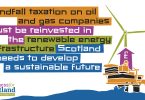Scotland has ambitions to play a lead role in the green hydrogen economy. But the UK Government’s lack of a coherent strategy is holding it back and it is now falling behind the EU and the USA. Here we take a look at some key issues.
What is green hydrogen?
Hydrogen is already in widespread use, largely in the fertiliser and petrochemical industries. Currently, nearly all of it is made by breaking apart hydrocarbon fossil fuels, which produces grey hydrogen and carbon dioxide. That gives off about a billion tonnes of carbon dioxide each year, two per cent of global greenhouse gas emissions.
But renewable power, whether wind, solar, or tidal, can be used to make green hydrogen instead,The biggest green hydrogen plant in Europe is in Spain, built by Iberdrola, the continent’s biggest utility company. Solar power is used to power electrolysis machines that split water into hydrogen and oxygen.
Currently green hydrogen is more expensive but the price is coming down fast. InterContinental Energy, one of the largest developers of carbon-free “green hydrogen” projects, is forecasting that the cost will be competitive with the grey variety by the end of the decade.
What can green hydrogen be used for?
The Spanish plant turns the hydrogen into ammonia for sustainable fertiliser. Iberdrola says within a few years it will be cheaper than the fossil fuel variety – which will help to undermine the economics of the fossil fuel industry.
Green hydrogen can also be used as fuel. Electricity works well for light cars but not for heavy vehicles or for ships which can’t easily connect to a grid. It will play a major part in the transition for shipping which currently burns heavy fuel oil and accounts for around 3 percent of global greenhouse gas emissions.
Green hydrogen is already being used in Australia to make iron mining zero carbon. A consortium of energy companies led by BP plans to build almost 2,000 wind turbines. The 26 gigawatts of energy the site expects to produce will be used to manufacture hydrogen to power the heavy machinery needed to operate the mine.
One of the most disruptive new hydrogen projects is a new steel factory at Lulea in Swedish Lapland, which uses green hydrogen to power the process instead of coke. Alone, this has the potential to reduce the Swedish carbon dioxide footprint by 10 per cent. SSAB plans to start full-scale industrial production in 2026.
Steel production accounts for about 7 percent of global greenhouse gas emissions. Today, it relies heavily upon blast furnaces, which heat iron ore with coke. But when green steel becomes competitive it will undermine the economics of traditional steel. In contrast, the UK recently gave the go ahead for a new coal mine to serve old-style steel-making foundries. But who will want to buy fossil fuel steel when green steel becomes cheaper?
Scotland has ambitious goals
The Scottish Government’s new Cabinet Secretary for Energy Neil Gray wants to lay the foundations to deliver 5 gigawatts of hydrogen production – more than 10% of Scotland’s current energy needs – by 2030 and to develop a hydrogen supply chain in Scotland. The UK’s target is 10 gigawatts.
Scotland is well placed to make hydrogen because of its abundant renewable energy potential – it has some of the best access to wind power and tidal power in the world. It has the potential to create much more than 5 GW – the Australian iron mine site alone will produce 5 times that.
Scotland’s ‘weak’ grid is holding back transition – green hydrogen can strengthen it
One of the main barriers to Scotland realising its renewable energy potential at the moment is the “weak” national grid, branded “a national scandal” by an industry expert recently. Privatised under Margaret Thatcher, it has been starved of investment and poorly regulated. Scottish renewable providers can’t connect their projects for decades if at all and are charged ten times what English providers have to pay to use it. Many projects are simply refused access – even if they promise not to push power back onto the grid when it is not needed.
Green hydrogen can be used to strengthen a renewables based grid. A hydrogen plant can be built next to a new wind project. “When the wind was blowing, the plant would produce hydrogen. It could also ramp down hydrogen production to supply power to the grid when it was most needed,” Professor Leah Stokes of the University of California wrote in the New York Times recently.
Many of Scotland’s proposed green hydrogen hubs such as at Inverness are now working to secure deals with private investors. The Scottish government is investing £10 million to encourage innovation in hydrogen but it doesn’t have the budget, capacity or borrowing powers to build green hydrogen facilities itself. It lives within a subsidy, regulation and investment regime set by the UK.
The EU, the USA, Australia and Canada have put strong subsidies in place
There is a tough global race to attract private investment. The USA passed a $369bn package of green investment known as the Inflation Reduction Act (IRA). Australia, Canada and the EU have all responded by offering strong state support for renewable energy including generous tax credits for green hydrogen. The figures show that they are now forging ahead of the ‘rest of world’ – which includes the UK – in green jobs and investment.
Pierre-Etienne Franc, a former industrial gas executive, is the CEO of HY24, a fund dedicated to hydrogen investments. He told the FT: “if you find the right schemes with the right policy support you can deliver green hydrogen at a price which is similar to grey (from fossil fuels). And then you will get a solid return.” That solid return is available right now in most of the developed world – but not the UK.
The UK sector is out in the cold when it comes to state support
A recent report from Renewables UK said “a complex and stop-start policymaking approach” has hindered the progress of green hydrogen projects. Just four megawatts is currently operational in the whole of the UK.
Brexit means that the UK is on its own, outside the EU’s green subsidy regime. Even the Conservative peer Richard Harrington, who is conducting a review of the effect of these green subsidies on the UK economy, admits the UK cannot go pound for dollar against the US and it is starting to trail behind. Brexit has made it harder generally to attract inward investment.
The UK is “just sleep walking” when it comes to developing green hydrogen, according to Australian mining magnate Andrew Forrest, one of the world’s biggest hydrogen investors.
Forrest told the FT his firm Fortescue has been examining the potential to produce green hydrogen in Scotland. But he said that the new subsidy regime in the US is shifting the focus away from the UK and other areas where there is less state support for green technology. “We will invest billions of dollars, eventually tens of billions, in the United States…You have to go where the returns are higher.”
An independent Scotland back in the EU would be much better placed to realise its power
Scotland has all the resources to make green hydrogen. It has plentiful wind, tidal, hydro and solar power potential. It could create the potential for new steel plants and new manufacturing capacity. Green hydrogen could also be valuable to strengthen the weak national electricity grid that ideological privatisation has bequeathed Scotland.
Scotland’s elected government has ambitious goals. But it is being held back by the UK. The post-Brexit UK is too small to compete with the subsidy regimes that most of the developed world has adopted. An independent Scotland back in the EU would be much better placed to realise its power.









In terms of H2 We have (Zero Green ) attempted to open an honest and open dialogue with SDI and Scotent in regards two disruptive hydrogen production technologies, that would see a considerably lower production cost, and in regards the PLAT system see H2 extracted from ocean water.
In as much as we shared detailed decriptive content minus IPR, the volumes and spin off uses existing from the initial device, growth potentials and employment creation with a predicted gross turnover circ £3billion per annum years 4-5.
One must queston the ability of any and all Scottish Departments to grasp UK disruptive technologies, after some time the amount of hubris relayed back meant, as a collective we decided to look into mainland Europe, notwithstanding we now have firm commitment from Brest Metropole, French Invesment Bank, and French Govt!